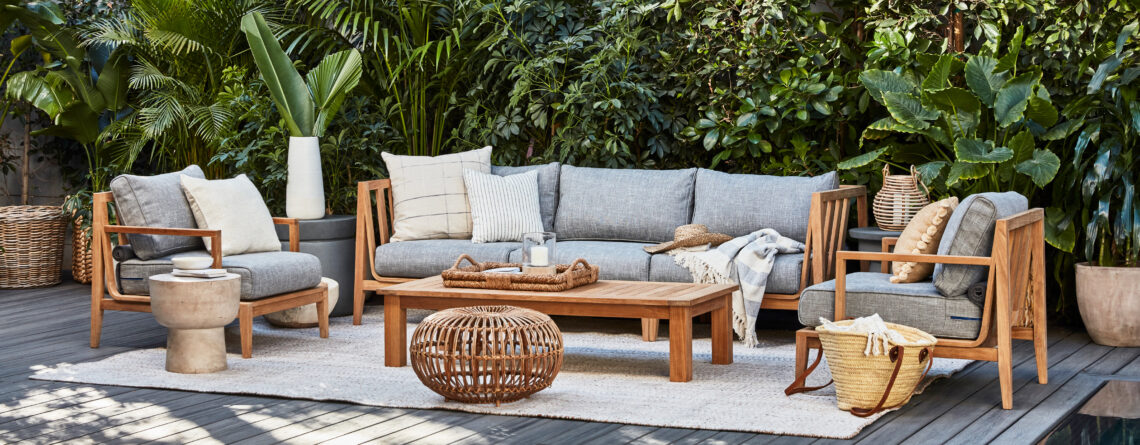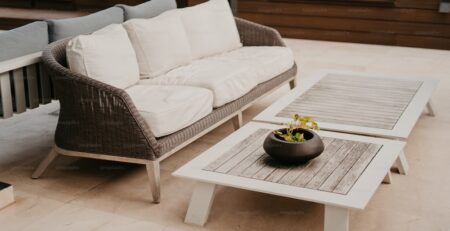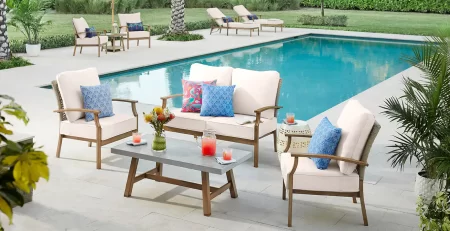3+ practices for sustainable outdoor furniture company
Sustainable manufacturing and eco-friendly materials are increasingly important topics in the world of outdoor furniture. As consumers become more environmentally conscious, they are looking for products that are made with sustainable practices and materials that are not harmful to the environment.
This has led to a rise in demand for becoming a sustainable outdoor furniture company, and manufacturers are responding by incorporating sustainable practices and materials into their production processes. Want to know how to corporate sustainability into your company as well? Keep reading this Eco Tech‘s article to find out!
1. Eco-friendly materials
One way that a sustainable outdoor furniture company can incorporating sustainability into their production processes is by using eco-friendly materials. These materials can include recycled plastics, reclaimed wood, and bamboo, which are all renewable and biodegradable. By using these materials, manufacturers are reducing their carbon footprint and helping to conserve natural resources. Besides that, here are some other practices you do:
-
Reduce Waste: A sustainable outdoor furniture company should also focus on reducing waste during the manufacturing process. This can be achieved by using materials that are recycled or upcycled, minimizing packaging and shipping waste, and finding ways to repurpose waste materials.
-
Design for Durability: A key aspect of sustainability is designing furniture that is built to last. This means using high-quality materials and designing products that are durable and can withstand the elements. By creating products that last longer, you reduce the need for frequent replacements and help prevent waste.
-
Choose Low-Impact Finishes: The finishing process of outdoor furniture can be a significant source of environmental impact. To minimize this impact, it is essential to decide on finishes that are low in volatile organic compounds (VOCs) and other harmful chemicals. Some eco-friendly options include natural oils and waxes, water-based stains, and low-VOC paints.

2. Manufacturing practices
A sustainable outdoor furniture company often aims to minimize the environmental impact of the manufacturing process while optimizing resource utilization and creating products that are safe for human use. In addition to using eco-friendly materials, manufacturers are also adopting sustainable manufacturing practices.
This includes reducing waste, conserving water and energy, and reducing emissions. Some companies are even using solar power to power their manufacturing facilities, further reducing their environmental impact.
Here are 3 popular sustainable manufacturing practices:
-
Resource Efficiency: Sustainable manufacturing practices prioritize resource efficiency by minimizing the amount of energy, water, and raw materials used during the manufacturing process. This can be achieved by using energy-efficient equipment, recycling, and reusing materials, and reducing waste.
-
Renewable Energy: The use of renewable energy sources, such as solar or wind power, can significantly reduce the carbon footprint of manufacturing. This can be achieved by installing solar panels, wind turbines, or other renewable energy sources on-site or sourcing renewable energy from external providers.
-
Lifecycle Assessment: Lifecycle assessment (LCA) is a method for evaluating the environmental impact of a product from its raw material extraction to its disposal. Sustainable manufacturing practices use LCA to optimize the design and manufacturing process to minimize environmental impact.
3. Packaging materials
Another trend in practicing to become a sustainable outdoor furniture company is the use of sustainable packaging materials. This not only reduces waste but also reduces the amount of energy required to produce and transport the packaging. Packaging materials are used to protect and transport products from the manufacturer to the end user.
However, the use of traditional packaging materials, such as plastics, can have a significant environmental impact. Here are some alternative sustainable packaging materials:
- Biodegradable Plastics: Biodegradable plastics are made from natural materials such as cornstarch, sugarcane, or potato starch. They are designed to break down quickly in a composting environment, reducing the amount of plastic waste in landfills.
- Recyclable Materials: Recyclable materials, such as paper, cardboard, and aluminum, can be easily recycled and turned into new products. These materials can be recycled multiple times, reducing the need for virgin materials and decreasing waste.
- Reusable Packaging: Reusable packaging, such as glass jars or metal tins, can be used multiple times, reducing the need for single-use packaging. This can be a cost-effective and environmentally friendly option for products that require durable packaging for a sustainable outdoor furniture company.
- Natural Materials: Natural materials, such as bamboo, hemp, or cotton, can be used as packaging materials. These materials are renewable, biodegradable, and can be sustainably sourced, making them an eco-friendly alternative to traditional packaging materials.

4. Carbon-Neutral Shipping
Shipping products to customers can be a significant source of carbon emissions for a business. To reduce their carbon footprint, a sustainable outdoor furniture company can aim to achieve carbon-neutral shipping by offsetting the emissions generated during shipping through the purchase of carbon credits or other carbon offset programs.
Carbon offsets can help fund projects that reduce greenhouse gas emissions, such as reforestation or renewable energy projects. By purchasing carbon credits or investing in other offset programs, a sustainable outdoor furniture company can offset the carbon emissions generated during shipping and make its products more environmentally friendly.
In addition to carbon-neutral shipping, the company can also explore other sustainable shipping practices, such as using sustainable packaging materials and optimizing shipping routes to reduce fuel consumption and emissions. These practices can help the company reduce its environmental impact while still providing customers with high-quality and sustainable outdoor furniture products.
Conclusion
Overall, the shift towards becoming a sustainable outdoor furniture company is a positive development for both the environment and consumers. As more firms embrace sustainability, we can look forward to a future where furniture is both beautiful and sustainable.











Leave a Reply